Un guide complet sur la façon de repérer les faux Yu-Gi-Oh ! Cartes

Dans l'univers de la collection de cartes Yu-Gi-Oh!, distinguer les cartes authentiques des contrefaçons est une compétence essentielle, tant pour les collectionneurs que pour les duellistes. Ce guide étape par étape, en japonais, vous apportera les connaissances et les techniques nécessaires pour repérer les fausses cartes Yu-Gi-Oh! en toute confiance. Il vous permettra notamment de repérer les fausses cartes Yu-Gi-Oh! et de distinguer les cartes authentiques des contrefaçons. Que vous soyez un collectionneur chevronné ou que vous débutiez dans l'aventure Yu-Gi-Oh!, maîtriser ces étapes vous aidera à protéger votre collection et à vous assurer que chaque carte de votre deck est authentique.
Table of Contents ▼
- À propos des véritables jeux de cartes à collectionner Yugioh! :
- Ce que vous devez savoir pour apprendre à repérer les fausses cartes Yu-Gi-Oh!
- Instructions détaillées pour identifier les fausses cartes à collectionner Yu-Gi-Oh!
- Que devez-vous faire si vous pensez que vos cartes Yu-Gi-Oh! sont contrefaites ?
- Conclusion
À propos des véritables jeux de cartes à collectionner Yugioh! :
En 1996, les cartes Yu-Gi-Oh! ont été introduites au Japon dans le cadre du manga et de l'anime Yu-Gi-Oh!, créés par Kazuki Takahashi. Ces premières cartes ne faisaient pas partie d'un jeu officiel, mais servaient d'élément narratif à la série. En 1999, le JCC Yu-Gi-Oh! a été officiellement lancé au Japon, produit par Konami pour le Jeu de Cartes à Collectionner Yu-Gi-Oh! (JCC) et le Jeu de Cartes Officiel Yu-Gi-Oh! (JCO) au Japon, suivi de sorties en Amérique du Nord et dans d'autres régions. Le JCC a introduit un ensemble de règles et de directives pour jouer au jeu de cartes.
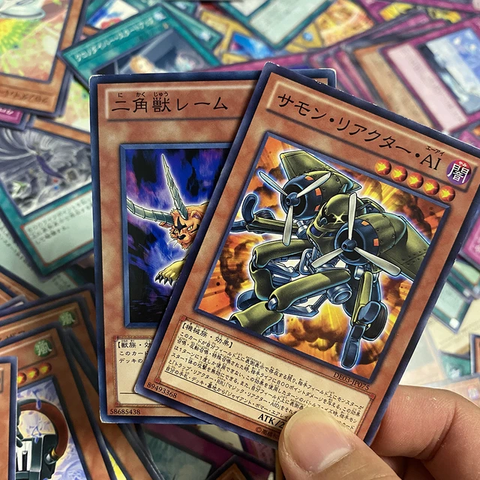
Caractéristiques principales des cartes Yu-Gi-Oh! authentiques : comment repérer une fausse carte Yu-Gi-Oh!
- Produit officiel Konami : Les cartes Yu-Gi-Oh! authentiques sont produites par Konami, éditeur et distributeur officiel du JCC Yu-Gi-Oh!. Ces cartes sont autorisées et sous licence, ce qui garantit leur authenticité.
- Dos des cartes : Le dos des cartes Yu-Gi-Oh! authentiques présente un design uniforme, avec le logo emblématique de Konami et les mentions de copyright. Leur apparence est uniforme, ce qui permet de repérer facilement les cartes authentiques.
- Symboles d'ensemble : Chaque carte appartient à un ensemble ou à une extension spécifique, identifié par un symbole d'ensemble sur la carte. Ces symboles aident les collectionneurs et les joueurs à classer et identifier les cartes.
- Numéros de carte : Les cartes authentiques possèdent des numéros uniques correspondant à leur jeu et à leur position dans ce jeu. Ces numéros sont imprimés sur la carte et facilitent son identification et son organisation.
- Feuilles holographiques : De nombreuses cartes Yu-Gi-Oh!, particulièrement les plus rares, présentent des motifs holographiques sur leur illustration. Ces feuilles peuvent varier en style et en rareté, ajoutant ainsi une valeur de collection à certaines cartes.
- Texte des cartes : Le texte des cartes Yu-Gi-Oh! authentiques est clair, lisible et la police est uniforme. Les cartes authentiques ne présentent aucune faute d'orthographe ni irrégularité.
- Indicateur de rareté : Les cartes Yu-Gi-Oh! sont souvent classées par rareté : commune, rare, super rare, ultra rare et rare secrète. Chaque niveau de rareté est indiqué sur la carte.
- Tournois officiels : Des cartes Yu-Gi-Oh! authentiques sont requises pour participer aux tournois officiels Yu-Gi-Oh!. Les contrefaçons sont strictement interdites en compétition.
- Valeur de collection : De nombreuses cartes Yu-Gi-Oh! authentiques ont une valeur de collection, les cartes rares et recherchées devenant très précieuses parmi les collectionneurs.
- Matériaux de qualité : Les cartes authentiques sont fabriquées avec des matériaux de haute qualité, notamment du papier cartonné et des techniques d'impression spécifiques, ce qui donne une texture et une apparence distinctes.
Globalement, pour répondre à la question « Comment repérer les fausses cartes Yu-Gi-Oh! japonaises ? », il est essentiel de connaître les véritables cartes Yu-Gi-Oh!, qui constituent l'épine dorsale du JCC Yu-Gi-Oh!. Elles fournissent aux joueurs les cartes nécessaires pour construire des decks et s'engager dans des duels stratégiques. Les collectionneurs apprécient également ces cartes pour leur rareté et leur importance historique au sein de la franchise Yu-Gi-Oh!.
Produit associé : Yu-Gi-Oh! OCG Duel Monsters Power Of The Elements Box CG1793
Ce que vous devez savoir pour apprendre à repérer les fausses cartes Yu-Gi-Oh!
- Observez attentivement votre carte pour déceler toute police étrange, faute d'orthographe ou de grammaire, ou si le nom de la carte est écrit en minuscules. Si vous constatez l'un de ces problèmes, il s'agit probablement d'une fausse carte.
- Inspectez les symboles sur la carte. S'il manque un symbole d'attribut dans le coin supérieur droit ou si les étoiles en haut à gauche semblent de mauvaise qualité, il pourrait s'agir d'une contrefaçon.
- Vérifiez les erreurs de conception telles que les logos manquants, les tampons en aluminium en bas à gauche et les marques déposées.
- Avant d'acheter des cartes, faites quelques recherches. Prenez note des statistiques de la carte et enregistrez des photos pour les comparer avec d'éventuels achats ultérieurs.
Article connexe : Le pouvoir des cartes dévoilé : TOP 7 des meilleures cartes Yu-Gi-Oh ! à collectionner
Instructions détaillées pour identifier les fausses cartes à collectionner Yu-Gi-Oh!
Instruction 1 : Vérification du texte de la carte :
Étape 1 : Examinez attentivement la police du texte . En cas de doute sur l'authenticité d'une carte, comparez son texte à celui d'une carte authentique pour repérer toute différence. Si vous ne disposez pas d'une carte physique pour comparer, vous pouvez rechercher une carte authentique en ligne. Les contrefaçons ou les fausses cartes Yu-Gi-Oh! présentent souvent une police différente de celle des cartes authentiques. Cette technique est également fréquemment évoquée sur les forums du JCC Yu-Gi-Oh!, lorsque l'on demande comment repérer les fausses cartes Yu-Gi-Oh!.
- De plus, les fausses cartes peuvent comporter du texte avec une taille de police plus grande que les cartes authentiques.
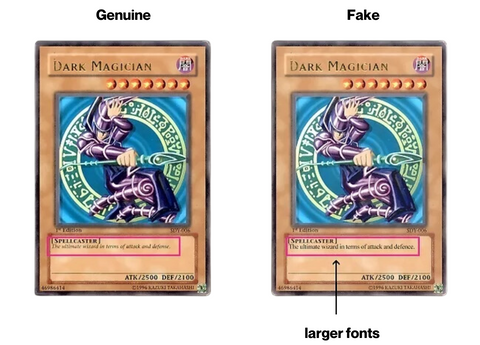
Examinez la police du texte.
Étape 2 : Vérifiez que le texte de l'effet ne comporte pas d'erreurs d'orthographe ou de grammaire, car les cartes contrefaites comportent souvent des traductions inexactes ou des descriptions mal rédigées. Examinez le texte de l'effet, généralement situé dans la section inférieure détaillant les capacités et les utilisations de la carte, pour détecter toute faute d'orthographe ou structure de phrase maladroite.
- De plus, examinez attentivement la présentation du texte. Si l'espacement ou le format d'une carte diffère des cartes authentiques, il s'agit probablement d'une contrefaçon.
- Il est important de noter que toutes les cartes Yu-Gi-Oh! ne possèdent pas d'effets. Certaines cartes comportent un texte d'ambiance, qui présente l'histoire divertissante du monstre plutôt que ses pouvoirs en jeu. Contrairement au texte d'effet, le texte d'ambiance est systématiquement présenté en italique.
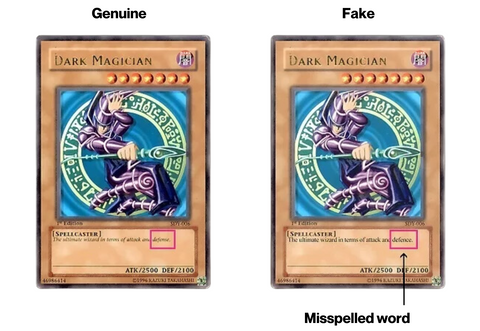
Vérifiez les erreurs d’orthographe ou de grammaire dans le texte de l’effet.
Étape 3 : Vérifiez l'exactitude du texte de l'effet en effectuant une recherche en ligne pour trouver une version correcte du texte de la carte. Comparez-le ensuite à celui de votre carte pour déceler toute variation de formulation. Même des différences minimes indiquent qu'il s'agit d'une contrefaçon.
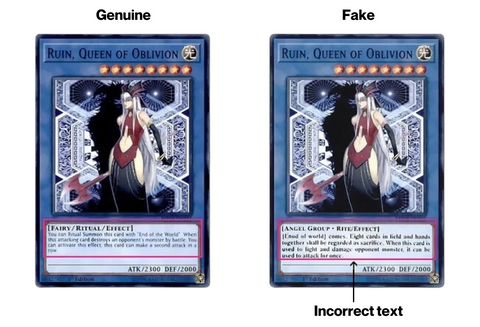
Assurez-vous de l'exactitude du texte de l'effet.
Étape 4 : Vérifiez que le nom de la carte ne contient pas de minuscules . Les cartes Yu Gi Oh! authentiques présentent systématiquement les noms de monstres ou de capacités en majuscules. Examinez attentivement votre carte pour identifier les minuscules. Si vous en voyez, c'est une indication claire qu'il s'agit d'une contrefaçon.
- Il est important de noter que même si le texte de l'effet sur la carte peut inclure des lettres minuscules, le nom de la carte doit toujours être en majuscules.
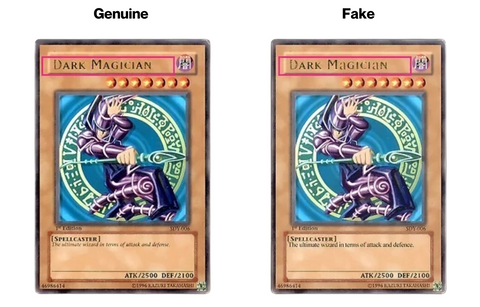
Vérifiez que le nom de la carte ne contient pas de lettres minuscules.
Étape 5 : Vérifiez l'exactitude des parenthèses et des barres obliques . Toutes les cartes Yu-Gi-Oh! sont classées par types, tels que les sorts, les pièges ou les différents types de monstres (comme les bêtes, les lanceurs de sorts, etc.), qui sont entre parenthèses et séparés par des barres obliques. De plus, les cartes de monstres incluent leurs valeurs d'attaque (ATK) et de défense (DEF), également séparées par des barres obliques.
- Assurez-vous également de vérifier l'espacement, car certaines cartes contrefaites peuvent avoir un espace supplémentaire avant ou après les barres obliques.
- Il est important de noter que les cartes de sorts et de pièges ne comportent pas de numéros d'attaque ou de défense.
- Pour accéder à une liste complète des monstres et des types de cartes, consultez le Guide Yu-Gi-Oh! sur le site officiel de Yu-Gi-Oh!.
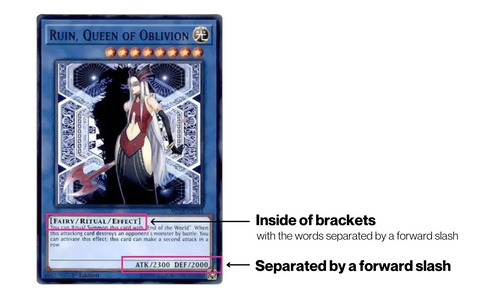
Évaluer l’exactitude des parenthèses et des barres obliques.
Instruction 2 : Examen des symboles des éléments :
Étape 1 : Examinez le symbole d'attribut situé en haut à droite de la carte . Pour apprendre à repérer les fausses cartes Yu-Gi-Oh!, il est nécessaire de connaître tous les détails de la carte, notamment le symbole . Ce symbole est constitué d'un caractère japonais surmonté d'une traduction anglaise. Vérifiez attentivement l'absence du symbole, l'inexactitude de la traduction anglaise ou toute faute d'orthographe dans la traduction.
- Les traductions anglaises possibles incluent : lumière, obscurité, feu, eau, terre, vent, divin, sort et piège.
- Remarque : dans le cas de cartes plus anciennes, le terme « magie » peut être utilisé à la place de « sort ».
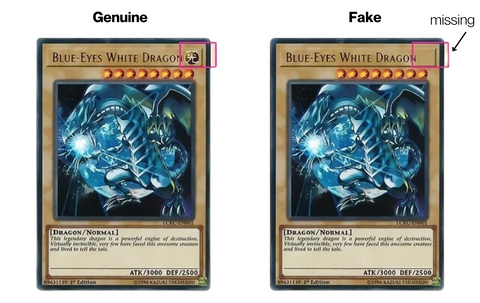
Inspectez le symbole d’attribut situé en haut à droite de la carte.
Étape 2 : Inspectez les étoiles de niveau sur les cartes monstres en vous concentrant sur les coins supérieur, droit et inférieur droit. Ces étoiles indiquent le niveau de la carte et sont représentées par des étoiles jaunes à 5 branches entourées d'anneaux rouge-orange. Soyez particulièrement attentif aux points supérieur, droit et inférieur droit de l'étoile de niveau, qui peuvent paraître faibles ou partiellement masqués par le fond rouge-orange. Examinez attentivement les étoiles pour déterminer si elles sont fixes ou s'il y a des différences notables.
- Comparez l'alignement des étoiles de niveau de la carte en question avec celles d'une autre carte authentique. Certaines cartes contrefaites peuvent présenter des étoiles de niveau mal alignées, ce qui peut être un signe révélateur de contrefaçon.
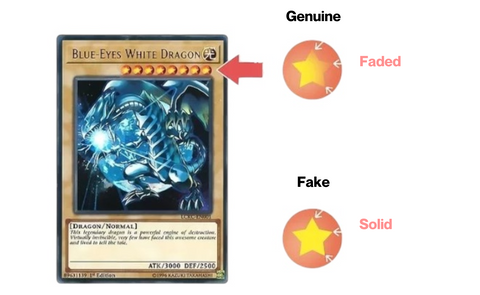
Examinez l’alignement des étoiles de niveau aux points supérieur, droit et inférieur droit.
Étape 3 : Utilisez des critères spécifiques pour vérifier les étoiles si la carte en question est un monstre Xyz . Les cartes Monstre Xyz Yu-Gi-Oh! ne comportent pas d'étoiles de niveau, mais des étoiles de rang, d'apparence légèrement différente. Une étoile de rang est représentée par une étoile jaune à 5 branches entourée d'un cercle noir. Toutes les branches de cette étoile doivent être clairement visibles, sans aucune décoloration ni opacité en arrière-plan. Si votre monstre Xyz ne possède pas ces étoiles de rang noires ou si les branches de ces étoiles semblent décolorées, il s'agit probablement d'une contrefaçon.
- Il est important de noter que les étoiles de rang n'apparaissent que sur les monstres Xyz. Si elles sont présentes sur une carte de tout autre type de monstre, celle-ci doit être considérée comme fausse.
- Les cartes monstres Xyz sont également dotées d'arrière-plans noirs sur le thème de l'espace et incluent le mot « Xyz » dans les crochets de type situés au-dessus du texte de l'effet.

Appliquez des critères différents lors de l'évaluation des étoiles s'il s'agit d'une carte monstre Xyz
Étape 4 : Assurez-vous qu'il n'y a pas d'étoile sur les cartes de sorts et de pièges. Les cartes de sorts ont un fond vert avec « sort » ou « magie » entre parenthèses au-dessus du texte de l'effet, tandis que les cartes de pièges ont un fond rose avec « piège » entre les mêmes parenthèses. Ni les cartes de sorts ni les cartes de pièges ne doivent avoir d'étoiles de niveau ou de rang. Si votre carte de sorts ou de pièges ne répond pas à ces critères, elle est probablement fausse.
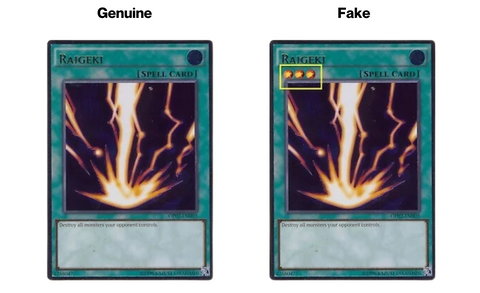
Confirmez que les cartes de sorts et de pièges ne contiennent aucune étoile.
Instruction 3 : Vérification de la conception globale de la carte :
Étape 1 : Vérifiez que les coins de la carte sont arrondis . Les cartes Yu-Gi-Oh! authentiques présentent systématiquement une bordure noire aux coins légèrement incurvés. Vérifiez si les coins de la carte sont pointus ou anguleux. Si c'est le cas, cela indique qu'il s'agit d'une contrefaçon.
- De plus, soyez prudent si les coins de la carte sont excessivement arrondis.

Vérifiez les coins arrondis sur les bords de la carte
Étape 2 : Utilisez votre doigt pour sentir la texture de la carte. Frottez délicatement la surface de la carte du bout du doigt pour en percevoir la texture. Les cartes authentiques ont une finition brillante avec une surface en relief qui reflète parfaitement les caractéristiques de l'œuvre. En revanche, les cartes contrefaites ont une texture plate et rugueuse.
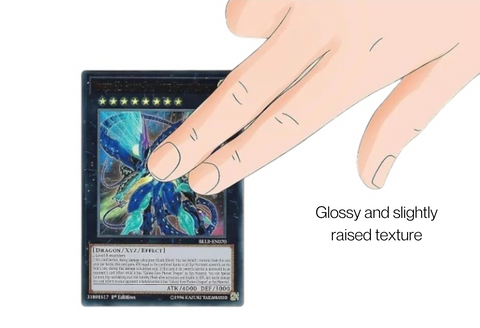
Passez votre doigt sur la surface de la carte pour évaluer sa texture
Étape 3 : Recherchez des signes de bordures de carte mal découpées . Vérifiez le recto et le verso de la carte pour voir si les bordures présentent des irrégularités ou semblent mal découpées. Si vous repérez de telles irrégularités, cela indique que la carte n'est pas authentique. Cette technique est souvent complexe en raison de son niveau de détail élevé et de son observation constante. C'est pourquoi ce détail est souvent négligé par les experts lorsqu'ils apprennent à repérer les fausses cartes japonaises Yu-Gi-Oh!.

Examinez les bordures de la carte pour détecter tout désalignement.
Étape 4 : Vérifiez le tampon métallique situé dans le coin inférieur droit de la carte. Les cartes authentiques comportent un tampon carré brillant à cet endroit, portant l'inscription « Yu-Gi-Oh ! » en petits caractères horizontaux. Les cartes contrefaites peuvent ne pas avoir ce tampon métallique, ou les lettres peuvent être disposées verticalement.
- La feuille d'une carte authentique sera dorée ou argentée. Toute autre couleur indiquera une contrefaçon.
- De plus, toutes les cartes Yu-Gi-Oh! possèdent un numéro d'édition situé au-dessus de la zone de texte d'effet, à droite. Si votre carte ne possède pas ce numéro, elle n'est pas authentique.
Remarque : La feuille d'or indique qu'il s'agit d'une première édition ou d'une édition limitée, ce qui en fait une carte YuiGiOh très prisée . Si une carte est étiquetée ou vendue comme une première édition ou une édition limitée, mais porte un marquage argenté, elle est contrefaite.
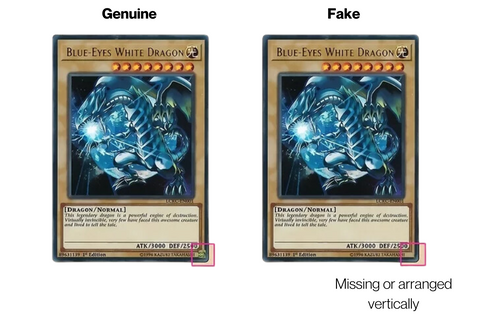
Inspectez le tampon en aluminium situé dans le coin inférieur droit de la carte.
Étape 5 : Vérifiez l'exactitude du design, du logo et de la marque déposée au verso de la carte . Les cartes Yu-Gi-Oh! présentent généralement un fond tourbillonnant orange foncé avec un ovale noir ressemblant à un portail au centre. En bas à droite, vous trouverez le logo officiel Yu-Gi-Oh! accompagné d'un symbole de marque déposée. Vérifiez si l'un de ces éléments est absent ou mal positionné. Si c'est le cas, cela indique que la carte est contrefaite.
- La bordure au dos de la carte doit être légèrement plus épaisse que la bordure au recto de la carte.

Valider l'exactitude du design, du logo et de la marque au dos de la carte
Instruction 4 : Être un acheteur intelligent :
Étape 1 : Vérifiez le nom et les statistiques de la carte lors de son acquisition , même si vous l'achetez dans un magasin réputé ou si elle est dans un emballage scellé. Se fier uniquement à la source n'est pas toujours fiable. Pour vous assurer que les cartes sont authentiques et adaptées à votre deck, vérifiez qu'elles portent le nom correct et les statistiques exactes.
- Ces statistiques incluent les attributs ainsi que le niveau ou le rang.
- Certaines cartes Yu-Gi-Oh! ont été légèrement renommées car elles ont été ajoutées à un archétype unique. Par exemple, « Soldat cinétique » est devenu « Soldat Cipher » avec la sortie de la collection « Cipher ». Les cartes renommées et originales sont considérées comme authentiques.
- Si vous avez des doutes sur le nom de la carte, consultez une liste de cartes renommées pour vérifier que le changement de nom est légitime et ne résulte pas d'une contrefaçon.

Vérifiez le nom et les statistiques des cartes que vous achetez
Étape 2 : Comparez deux cartes identiques pour repérer les différences . Que vous achetiez des cartes en ligne ou en magasin, assurez-vous de comparer les cartes vendues avec les vraies. Si vous constatez des différences, il s'agit probablement de fausses cartes.
- Certains vendeurs Yu-Gi-Oh! en ligne peuvent étiqueter leurs cartes « orica », ce qui signifie qu'il ne s'agit pas de cartes authentiques. Ce sont des créations originales réalisées par des fans et des amateurs de Yu-Gi-Oh!, avec des designs uniques. Elles ne sont pas utilisables en jeu, mais peuvent constituer de superbes objets de collection.

Comparez deux cartes identiques pour identifier d'éventuelles divergences
Étape 3 : Renseignez-vous soigneusement sur les boutiques en ligne et les types de cartes que vous envisagez d'acheter . Familiarisez-vous avec tous les détails et statistiques de vos cartes Yu-Gi-Oh! à l'avance. Assurez-vous d'avoir des informations précises en consultant le site officiel de Yu-Gi-Oh!. Ensuite, demandez conseil à des sources fiables et à des boutiques en ligne réputées ayant reçu des avis positifs sur le prix et la qualité des différents types de cartes. Enfin, choisissez le produit qui correspond à vos besoins.
- Vérifiez également les prix des cartes Yu-Gi-Oh! pour connaître la valeur marchande habituelle de chaque carte. Si quelqu'un propose une carte à 500 $ à 9,50 $, elle n'est probablement pas authentique.
- Explorez divers forums en ligne pour obtenir des informations sur les cartes et apprenez à repérer les fausses versions japonaises des cartes Yu-Gi-Oh!.
- Soyez vigilant lorsque vous envisagez des achats sur des sites Web non officiels comme AliExpress, Taobao ou d'autres sites Web chinois non autorisés.
Article connexe : Les cartes Yu-Gi-Oh! les plus puissantes que vous ne connaissez peut-être pas
Que devez-vous faire si vous pensez que vos cartes Yu-Gi-Oh! sont contrefaites ?
Étape 1 : Confirmer leur légitimité
- Commencez par vérifier l'authenticité des cartes. Pour ce faire, comparez soigneusement vos cartes aux images de cartes authentiques disponibles sur divers forums Yu-Gi-Oh!, plateformes de commerce électronique ou chaînes YouTube gérées par des experts du JCC Yu-Gi-Oh!. En cas de doute, demandez conseil à des experts dans un magasin de jeux vidéo près de chez vous, partagez des photos des cartes dans un jeu Yu-Gi-Oh! ou recherchez « comment repérer les fausses cartes Yu-Gi-Oh! » sur les réseaux sociaux et demandez confirmation à d'autres passionnés.
Étape 2 : Contactez le vendeur
- Si le vendeur ignorait réellement que la boîte de boosters contenait de fausses cartes, il pourrait être disposé à proposer un remboursement. Pour faciliter cette démarche, présentez toutes les preuves disponibles et partagez cet article avec lui. Malheureusement, si le vendeur est frauduleux, vos options pourraient être limitées. Dans ce cas, surtout si l'achat a été effectué en ligne, pensez à contacter le service client du site web ou de la plateforme e-commerce, comme Amazon ou eBay, pour obtenir de l'aide.
Étape 3 : Initier un litige
- La plupart des sites web proposent un service client. Recherchez des liens comme « Aide », « Contact » ou « Assistance », généralement situés en pied de page. Sur de nombreuses plateformes de e-commerce internationales, le vendeur peut être amené à approuver un retour. Dans ce cas, vous devrez suivre la procédure de retour, documenter le dépôt du colis par une vidéo et sélectionner un mode d'expédition avec suivi.
Étape 4 : Partagez votre expérience et sensibilisez
- Que vous receviez ou non un remboursement, il est désormais de votre responsabilité d'aider les autres personnes confrontées à une situation similaire. Partagez votre histoire sur les réseaux sociaux pertinents que vous suivez afin de protéger d'autres personnes contre d'éventuelles arnaques. Si vous souhaitez contribuer à la lutte contre les arnaqueurs aux cartes Yu-Gi-Oh!, pensez à partager cet article.
Conclusion
En conclusion, maîtriser l'art d'identifier les fausses cartes Yu-Gi-Oh! est essentiel pour tout collectionneur et joueur. Que vous soyez à la recherche de cartes contrefaites, en version standard ou japonaise, cette connaissance vous permettra de préserver votre collection et votre expérience de jeu. En examinant minutieusement l'apparence des cartes, en scrutant le texte, en examinant leur dos et en vérifiant leur estampille, vous pourrez distinguer en toute confiance les vraies cartes des fausses. Grâce à ces conseils pour repérer les fausses cartes Yu-Gi-Oh!, vous serez bien équipé pour garantir l'authenticité de vos précieuses cartes, préservant ainsi l'intégrité de votre collection et le plaisir de vos aventures Yu-Gi-Oh!.
De plus, si vous recherchez une destination réputée et fiable au sein de la communauté Yu-Gi-Oh! JCC, avec des prix compétitifs et une qualité irréprochable, Japan-Figure est le choix idéal. Grâce à un processus d'achat rapide, un service client pratique et un engagement à fournir des produits Yu-Gi-Oh! JCC 100 % authentiques de la marque Konami, Japan-Figure propose régulièrement des jeux de cartes parmi les plus rares et de la plus haute qualité. Suivez donc notre site web Japan-Figure pour découvrir les dernières actualités concernant les produits Yu-Gi-Oh! JCC.

Laisser un commentaire